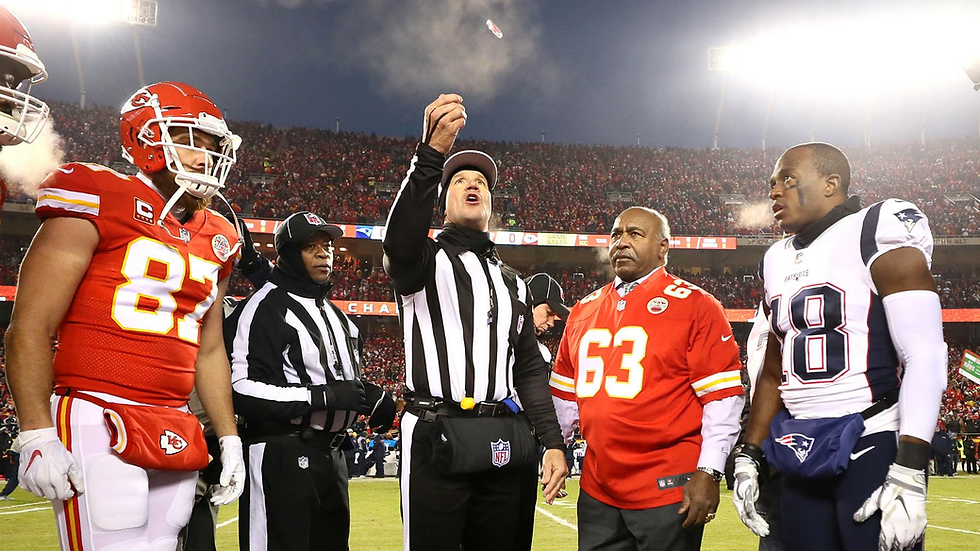Can we fix overtime in the NFL?
- Vibhav Chincholi
- May 26
- 3 min read
Updated: Aug 30

If you have ever watched an NFL game reach overtime only to see it end after a single drive, you might have felt frustrated or disappointed. For years, fans and players have criticized the league’s overtime rules because the result often seems determined by luck rather than skill or strategy. Overtime can be exciting and tense, but a sudden ending can leave many wondering whether both teams truly had a fair chance to compete.
The NFL has adjusted its rules multiple times in response to these concerns, yet debate continues over whether the changes go far enough. Examining how overtime has evolved over the years helps explain why so many people are still calling for reform.
The Problem with Sudden Death
For decades, the league used a sudden-death format in which the first team to score won the game, whether by touchdown or field goal. This method was simple and decisive, but it revealed a significant flaw. The coin toss became a major factor in deciding outcomes. If the team that won the toss chose to receive and scored a touchdown, the game ended immediately. The opposing team would never touch the ball, a scenario that often felt unfair, especially in playoff games where an entire season could hinge on a single possession.
The 2019 AFC Championship clearly illustrated this problem. Patrick Mahomes and the Kansas City Chiefs never had the opportunity to take the field in overtime against the New England Patriots. The Patriots scored on their opening drive, ending the game instantly. Situations like this convinced many fans and players that the league needed to rethink its overtime rules.
How the Rules Have Changed
The first major change came in 2010. Playoff games were adjusted so that if the opening drive resulted in a field goal, the other team would have a chance to respond. If both teams kicked field goals, the game would continue under sudden death. However, if the first drive ended in a touchdown, the game still ended immediately. While this adjustment slightly improved fairness, it did not eliminate the problem. Teams winning the coin toss still had a significant advantage.
Another high-profile game in 2022, between the Buffalo Bills and Kansas City Chiefs, highlighted the same issue. The Chiefs scored on their first overtime possession, leaving the Bills without a chance to respond. After this, the NFL created a new postseason rule ensuring both teams are guaranteed at least one possession in overtime. Regular-season rules remain unchanged, but this move represented progress toward a fairer system.
Ideas for Further Reform
Despite these changes, discussion about overtime fairness continues. Critics argue the system can still favor one team and that the league should explore additional solutions. Several proposals have gained attention.
One idea is to extend the postseason rule to all games, guaranteeing each team a possession. Evidence shows that games where both teams have a chance to play in overtime feel more balanced and satisfying. However, longer games could increase player fatigue and injuries, which is a serious concern for the league.
Another suggestion is the Spot and Choose system. In this approach, one team picks the yard line for the start of play, while the other chooses whether to play offense or defense. This strategy removes the dominance of the coin toss and requires careful planning. Although smaller leagues have tested this method successfully, it would represent a major change from traditional NFL overtime and might take time for fans and players to accept.
Some propose adopting the college football system, where each team starts a possession at the opponent’s 25-yard line until one team outscores the other. This ensures equal opportunities and creates exciting back-and-forth action. Critics argue, however, that it changes the character of NFL games by removing elements like field position and clock management.
Finally, some suggest a full overtime period of 10 or 15 minutes, similar to basketball or soccer. Both teams would have time to play within the normal flow, and the better team would likely win. While this reduces randomness, it also creates longer games, raising concerns about player safety and exhaustion.
Conclusion
The NFL has made progress in making overtime fairer, especially with recent postseason changes. Yet the issue is far from resolved. Each proposed reform has advantages and disadvantages, and there is no clear solution that satisfies everyone. What remains clear is that fans and players want a system where the winner earns the victory on the field, not because of a coin toss. As the league continues to adjust its rules, finding a balance between fairness, excitement, and player safety will remain a challenging task.




Comments